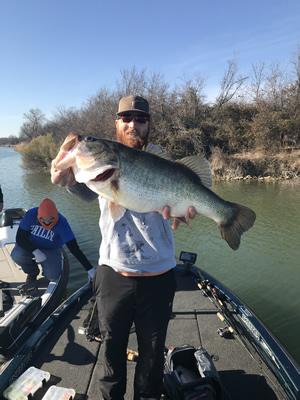 March 9, 2018 - The height of the Texas big bass season isn't even here yet and the Texas Parks and Wildlife Department's Toyota ShareLunker program has already set a new record for total entries.
March 9, 2018 - The height of the Texas big bass season isn't even here yet and the Texas Parks and Wildlife Department's Toyota ShareLunker program has already set a new record for total entries.
It's not that monster bass have been overly active this year. The record pace has evolved because the department this year lowered the bar on the minimum weight required for entering a fish, created several more ways for anglers to play the game by following a simplified entry process that can carried out electronically using a Smartphone or home computer and put some really nice prizes on the table to lure them in.
Dating back to 1986, the big bass spawning and genetics research program has historically required that fish weigh 13 pounds or more to be eligible. The minimum weight for entry was set at 13 pounds based on the belief that jumbo bass have superior genetics offering the best shot for producing more giant bass though selective breeding.
While "13" remains the magic number for entering a fish in the spawning phase of the program, bass as small as eight pounds are now eligible for entry under a revamped framework aimed at drumming up more angler support.
The new format appears to be working on that front.
As of Feb. 21, program coordinator Kyle Brookshear said the program had accepted 47 entries over eight pounds from two dozen different lakes located from Panhandle to deep South Texas. That's 11 more than the 1994-95 record season that saw 36 entries over 13 pounds sent to the program headquarters in Athens.
The smallest fish entered this year is an 8.04 pounder. The biggest is a 12.79.
Lake Conroe has produced the most entries (9) of any lake thus far, including a 12.65 pounder. Lake Fork is second with seven and Lake LBJ has four entries.
ShareLunker staff are expecting the pace to pick up steam in coming weeks as more anglers learn about the program expansion and warming water temperatures beckon armies of big bass towards the shallows to spawn.
There are now four categories in which anglers can enter fish.
The program's lowest level category is called "Lunker Class." It is open for bass as small as eight pounds or 24 inches in length.
The next category up the ladder is for fish weighing between 10 and 12.99 pounds. It's called the "Lunker Elite."
There are two categories for fish weighing upwards of 13 pounds. "Lunker Legend" is for fish caught outside the Jan. 1 - March 31 spawning window, or fish caught inside the spawning window by an angler who for some reason declines to loan the fish to the state for spawning.
The "Lunker Legacy" category is for bass that carry on the heart and soul of the the program. These big girls weighing 13 pounds or more must be caught during the spawning window and loaned to the state for spawning.
Anglers who enter fish in either of the four categories are automatically registered in year-end drawings for cool prizes including fishing licenses and $5,000 shopping sprees to a national outdoor retailer. Also, each angler who plays the game earns a Toyota ShareLunker Catch Kit including fishing tackle, commemorative decals and ShareLunker branded merchandise. Enter a 13 pounder and you get a free replica of the fish. Lunker Legacy donars also get VIP access at the Toyota Bassmaster Texas Fest.
To learn more about the program, rules and qualification process, see texassharelunker.com.
Lake Conroe Big Bass Classic
The 2018 Lake Conroe Big Bass Classic set for March 2-4 with more than $63,000 guaranteed to be given way in hourly payouts and a new Nitro Z19 going to the angler that catches the biggest bass of the event. Weigh-ins will be held at Papa's on the Lake.
Entry fee is $110 for one day, $160 for two and $240 to fish all three days. Printable entry forms are available or you can register online at bigbasstour.com.
Salvinia on Athens
Texas Parks and Wildlife recently reported that Giant salvinia has been discovered at Lake Athens in eastern Texas. The Athens find, which spans roughly one acre, marks the second time in roughly three weeks that the invasive plant has been found on an East Texas reservoir. Earlier this month the aquatic fern was discovered at Lake Nacogdoches in area spanning roughly 30 acres.
TPWD's John Findeisen says the department's aquatic invasives team surveyed the impacted area at Athens and deployed a containment boom to contain the floating plants.
With the plant contained by the boom Findeisen says experts can better evaluate the situation and determine whether or not eradication is possible using herbicide.
TPWD chose not use herbicide on the Lake Nacogdoches infestation because the salvinia is intermingled with cut grass, torpedo grass and other more desirable types of aquatic vegetation.
“The containment boom is a critical component of our rapid response efforts to eradicate giant salvinia at Lake Athens,” Findeisen said. “Concentrating giant salvinia in an area helps prevent further spread and increases the efficiency and effectiveness of herbicide treatments, which is the next phase of our response at Lake Athens. Following that we should know fairly soon if eradication is a real possibility at the lake.”
As is the case with most new infestations, it is believed the plant was introduced to the 1,800 acre lake by a careless boater or angler carrying it on their boat, trailer or other equipment.
Giant salvinia is aggressive floating plant from South America that was first discovered in Texas on Toledo Bend in 1998. It has since been found on several more lakes throughout the region.
In addition to current infestations at Toledo Bend, Sam Rayburn and Caddo Lake, the invasive plant has been newly introduced or reintroduced at six Texas lakes since 2017: Lake Murvaul, Lake Palestine, Martin Creek Lake, Lake Fork, Lake Nacogdoches and now Lake Athens, according to TPWD reports.
TBGA entry deadline nearing
March 1 is the deadline for scored entries to the Texas Big Game Awards Program.
TBGA is a hunting heritage program jointly run by the Texas Parks and Wildlife Department and the Texas Wildlife Association. One of its main purposes is to promote quality big game management programs by recognizing hunters who take quality big game animals over the course of the season, and the landowners/land managers responsible for producing them.
TBGA has scored entry categories for whitetail deer, mule deer, pronghorn antelope and javelina in eight geographical regions. There are divisions for low fence, high fence, youth and first harvest.
All scored entries must be scored by a TBGA certified scorer and meet a minimum net Boone and Crockett score for the specific region in order to qualify. The minimums for whitetail deer taken in the Pineywoods and Post Oak regions of eastern Texas are 125 for typicals, 140 for non-typicals.









